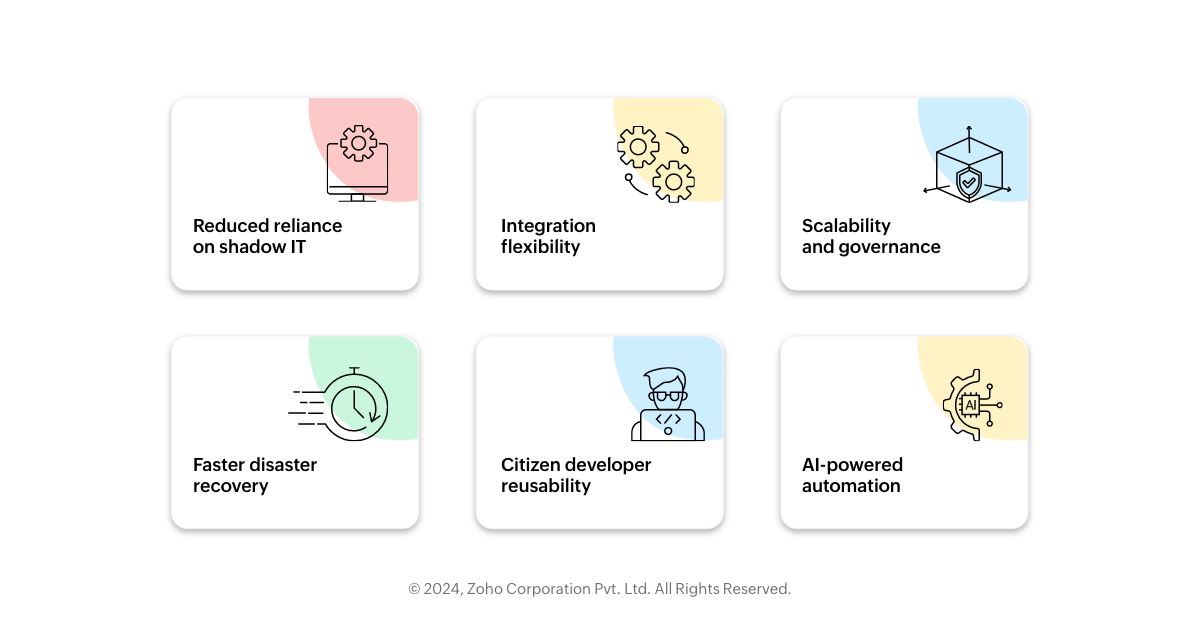- HOME
- Workflow automation
- Why your business needs digital workflows (and how to get started)
Why your business needs digital workflows (and how to get started)
- Last Updated: April 2, 2024
- 227 Views
- 4 Min Read

Have you ever spent hours filling out expense reports, only to have them languish in a manager's inbox for days? Or maybe you're drowning in a sea of sticky notes keeping track of customer service requests. If so, you're not alone. Manual workflows are the bane of businesses everywhere, creating bottlenecks, wasting time, and hindering productivity.
These outdated, paper-based processes are more than just annoying—they're costing your company money. Imagine the wasted hours spent chasing approvals or re-entering data into different systems. Thankfully, there's a solution: low-code workflow automation.
What is low-code?
Low-code development is a game-changer for businesses looking to ditch the paper trail and embrace digital efficiency. Think of it as building workflows with Legos—instead of lines of code, you use drag-and-drop features and prebuilt components to design automated processes. The best part? You don't need to be a programming whiz. Low-code empowers citizen developers and regular business users with little-to-no coding experience to build custom applications that streamline their daily tasks.
So, why should you use low-code for workflow automation? Here are some compelling reasons:
Faster development: Low-code cuts through the lengthy coding process, allowing you to build and deploy workflows in a fraction of the time.
Reduced costs: Citizen developers can take the reins, freeing up IT resources for more complex projects.
Increased efficiency: Say goodbye to redundant tasks and hello to a smoother, faster way of getting things done.
Improved accuracy: Eliminate the human error that comes with manual data entry.
Scalability: Low-code workflows can adapt and grow alongside your business needs.
But the benefits extend beyond just the development process.
Here's how digital workflows can supercharge your business
Implementing digital workflows can have tons of benefits in your organization. Let's take a look at some of these below.

• Reduced reliance on shadow IT: Low-code empowers business users to build secure, sanctioned workflows within the IT framework. This minimizes the creation and use of unsupported shadow IT solutions that can pose security risks.
• Integration flexibility: Many low-code platforms offer prebuilt connectors and APIs that simplify integration with existing enterprise systems and data sources. This allows for building workflows that bridge disparate data silos and streamline complex processes.
• Scalability and governance: Low-code platforms can handle high volumes of data and workflows, making them suitable for growing businesses. Additionally, features like role-based access control and version control ensure proper governance and security for critical workflows.
• Faster disaster recovery: Low-code platforms often provide built-in disaster recovery features that automate backups and streamline recovery processes. This minimizes downtime and ensures business continuity in case of unforeseen disruptions.
• Citizen developer reusability: Low-code platforms encourage the creation of reusable components and workflows. This allows citizen developers to build upon existing functionalities, reducing development time and promoting consistency across workflows.
• AI-powered automation: Some advanced low-code platforms allow incorporating AI capabilities into workflows. This enables automating tasks based on machine learning models, further enhancing efficiency and decision-making.
Some further benefits include:
Enhanced visibility: Gain real-time insights into your workflows, allowing you to identify bottlenecks and optimize processes.
Improved collaboration: Break down departmental silos and foster seamless collaboration across teams.
Increased customer satisfaction: Deliver faster and more efficient service with automated workflows.
Reduced errors: Automated processes minimize the risk of human error, leading to more accurate results.
Better decision-making: Data-driven insights from digital workflows empower you to make informed decisions.
A roadmap for low-code
Building a low-code workflow is surprisingly simple. First, initiate the transformation by meticulously outlining your existing paper-based workflow. This includes documenting each step involved and pinpointing any decision points, such as approvals or routing procedures. By thoroughly understanding your current processes, you'll be well-equipped to translate them into a seamless digital experience.
Next, delve into the realm of digital workflow platforms. Numerous low-code options cater to a variety of needs. Conduct thorough research to select the platform that perfectly aligns with your specific requirements. This paves the way for the design and construction phase, where you'll leverage the platform's intuitive interface and pre-built components to visually construct your streamlined workflow. Once you're confident in your creation, run a few tests to ensure it functions flawlessly. Finally, unleash your digital masterpiece and empower your operations!
Use cases for low-code
Low-code workflow automation isn't just a techie trend—it's transforming businesses across industries. Here are a few real-world examples:
HR: Automate the onboarding process for new hires, eliminating paperwork and streamlining the integration process.
Customer service: Route customer inquiries to the right department automatically, improve response times, and track resolution progress.
Project management: Assign tasks, track deadlines, and receive automated notifications in a centralized platform, keeping projects on track.
Ready to ditch the paper and embrace the power of digital workflows? When choosing a low-code platform, consider factors like the features offered, ease of use, scalability, and security. Many platforms like AppCreator provide free trials and tutorials to get you started. There are also vibrant low-code communities online where you can learn from other users and share your experiences.
Don't let manual workflows hold your business back any longer. Explore the world of low-code development and unleash the magic of digital efficiency! By embracing low-code automation, you can streamline your operations, empower your employees, and free up valuable time to focus on what matters most: Growing your business.



